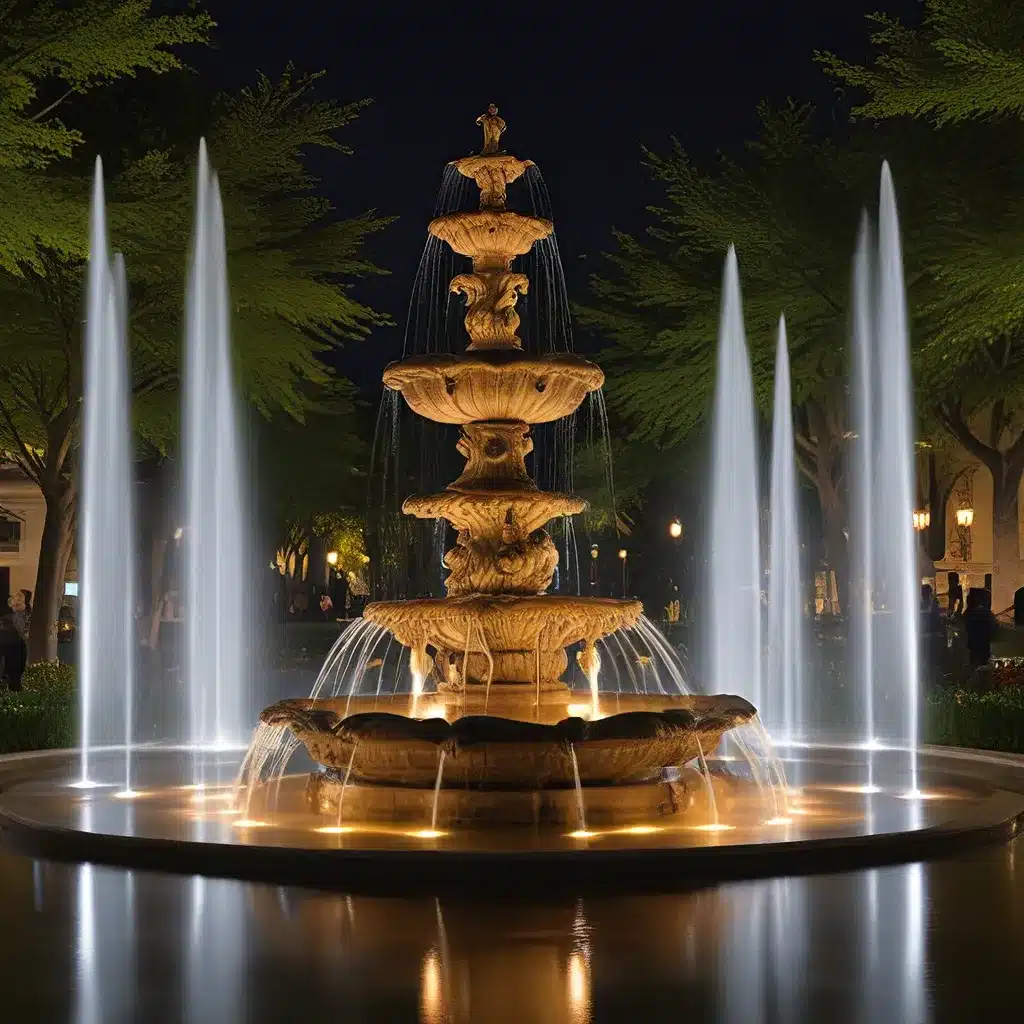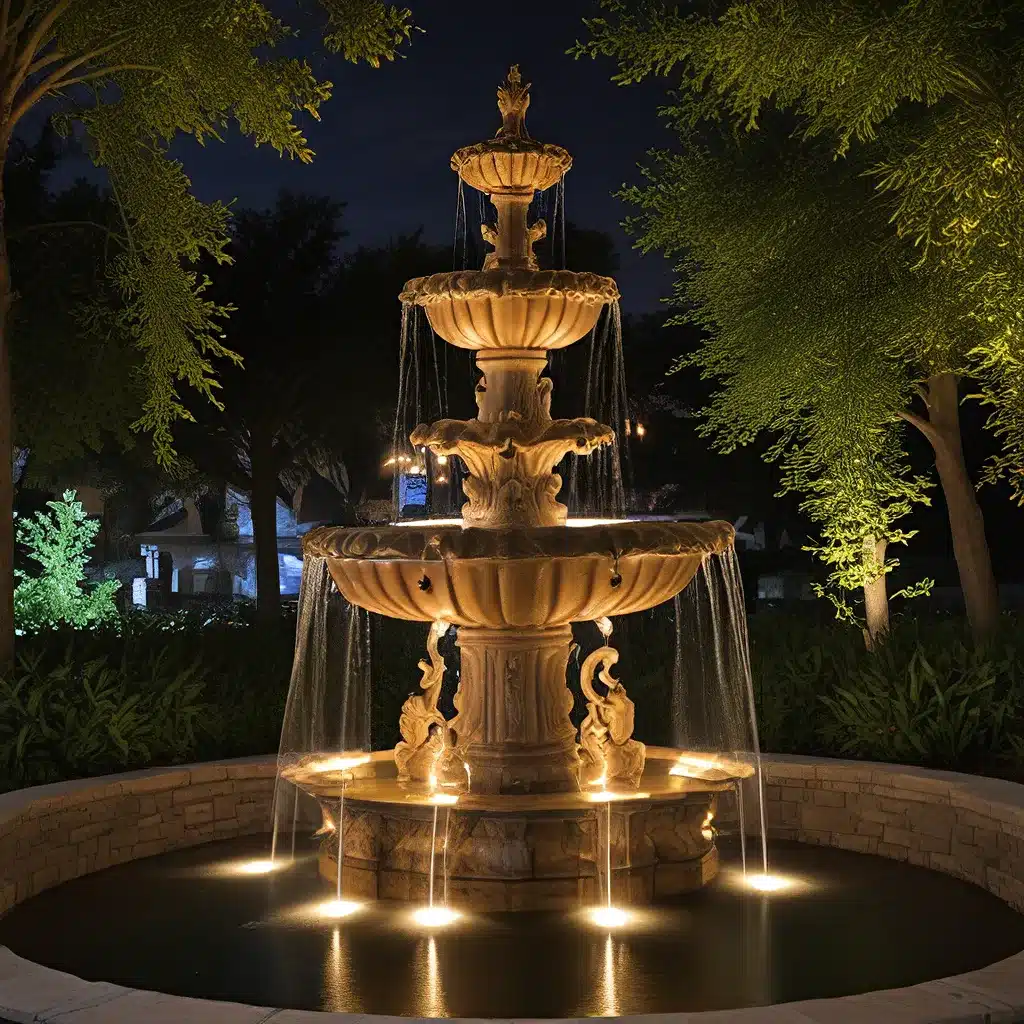
Fountain Design Essentials – Welcome to Fountain Lights
Fountain Design Essentials – Welcome to Fountain Lights

As an avid explorer of architectural wonders, I’ve always been captivated by the interplay of light, shadow, and the built environment. But it wasn’t until I stumbled upon the enchanting world of fountain lighting design that I truly understood the power of engaging all the senses.
You see, for far too long, the focus in architecture has been predominantly on the visual, leaving the other sensory realms largely neglected. But those who dare to challenge this ocular-centric approach are the true visionaries – the ones who recognize that the most transformative experiences arise when we immerse ourselves in a symphony of sensations.
And that’s precisely what drew me to the world of fountain lighting. It’s a realm where the boundaries between sight, sound, and even touch become delightfully blurred, creating an atmosphere that captivates the mind and stirs the soul.
As I delved deeper into the subject, I discovered that the true magic of fountain lighting lies in its ability to harmonize multiple sensory inputs. It’s not just about illuminating the water’s surface – it’s about orchestrating a harmonious interplay of light, shadow, and the soothing sound of cascading water.
Imagine standing before a magnificent fountain, where the soft glow of strategically placed lights casts a warm embrace over the surrounding space. The gentle rippling of the water creates a hypnotic rhythm, lulling you into a state of tranquility. And as you reach out to trace the intricate patterns formed by the water’s flow, you’re met with a tactile experience that heightens your connection to the environment.
It’s a sensory symphony that transcends the visual, inviting you to immerse yourself in the very essence of the space. And the truly remarkable thing is that this sensory experience can be carefully crafted and curated by the skilled hand of a fountain lighting designer.
What sets the best fountain lighting designs apart is their ability to engage multiple senses simultaneously. It’s not enough to simply illuminate the water; the true masters of this craft understand that the most captivating experiences arise when we can see, hear, and feel the environment around us.
Take, for example, the Ira Keller Fountain in Portland, Oregon. Described by architect Juhani Pallasmaa as “an architecture for all the senses,” this fountain masterfully blends light, sound, and tactile elements to create a truly immersive experience. The cascading water not only delights the eyes but also fills the air with a soothing, rhythmic melody. And as you reach out to touch the surface, the temperature of the water adds yet another sensory layer to the encounter.
It’s this harmonious integration of multiple sensory inputs that truly sets the stage for unforgettable experiences. And it’s a principle that can be applied to fountain lighting designs of all scales, from grand public displays to intimate backyard oases.
So, what does it take to create a fountain lighting design that captivates the senses? It starts with a deep understanding of how the human mind perceives and processes information from multiple modalities.
Recent advances in cognitive neuroscience have revealed the remarkable extent to which our senses interact and influence one another. Far from operating in isolated silos, our visual, auditory, tactile, and even olfactory systems are constantly communicating with one another, shaping our overall experience of the world around us.
By embracing this multisensory approach, fountain lighting designers can craft environments that resonate on a deeper, more profound level. It’s not just about creating a beautiful spectacle; it’s about designing for the multisensory mind, ensuring that every element of the experience seamlessly complements and enhances the others.
One of the key principles that guides the most successful fountain lighting designs is the concept of crossmodal congruency. This refers to the way in which sensory inputs from different modalities can either harmonize or conflict with one another, influencing our overall perception and emotional response.
Imagine, for instance, the impact of pairing a soothing, low-tempo musical score with the rhythmic flow of a fountain’s water. The synergy between the auditory and visual elements creates a sense of tranquility and relaxation, inviting visitors to slow down and fully immerse themselves in the experience.
Conversely, a discordant combination of sensory inputs – such as a jarring, high-pitched sound paired with erratic water patterns – can lead to feelings of discomfort and unease. It’s a delicate balance that fountain lighting designers must constantly navigate, ensuring that each sensory element complements and enhances the others.
As the field of fountain lighting design continues to evolve, we’re seeing a growing emphasis on innovative approaches that push the boundaries of what’s possible. From the incorporation of dynamic, color-changing lighting to the integration of interactive technologies, the possibilities for captivating multisensory experiences are truly endless.
Take, for example, the Barclays Center in Brooklyn, New York. Upon its opening in 2013, the arena made headlines for its distinctive fragrance – a carefully curated scent that was deliberately infused into the space to create a signature sensory experience. This integration of olfactory elements alongside the visual and auditory components of the fountain design is a testament to the power of engaging multiple senses.
And in the Philips Pavilion at the 1958 Brussels World’s Fair, architect Le Corbusier and composer Iannis Xenakis collaborated to create a truly immersive multimedia experience, blending color, light, and sound in a way that challenged the traditional boundaries of architecture and performance.
As I continue to explore the world of fountain lighting design, I’m struck by the endless possibilities that lie ahead. With advancements in technology, materials, and our understanding of human perception, the potential for crafting truly transformative multisensory experiences has never been greater.
But beyond the technical innovations, what excites me most is the shift in mindset that’s taking place. More and more architects, designers, and urban planners are recognizing the vital importance of engaging all the senses, not just the visual. They’re embracing the idea that the most profound and memorable experiences arise when we can see, hear, touch, and even smell the environments we inhabit.
So, as you stroll through the next magnificent fountain display, I encourage you to pause and take it all in. Notice the way the light dances across the water’s surface, the gentle murmur of the cascading streams, and the subtle tactile sensations as you reach out to trace the flow. Allow yourself to be fully immersed in the sensory symphony, and you’ll begin to understand the true power of fountain lighting design.
After all, it’s not just about illuminating the water; it’s about illuminating the soul, one sensory delight at a time. And with the innovative minds of today paving the way, the future of multisensory design is brighter than ever.
Explore our range of fountain lighting solutions to elevate your outdoor spaces and create unforgettable multisensory experiences.
Share to :
Subscribe to our newsletter for the latest in fountain design, innovative lighting ideas, and exclusive tips straight to your inbox. Join the community shaping the future of water features.

Rapid delivery to your doorstep.

Excellence in every product.

Great value for your investment.

Assistance at any hour.
Fountain Lights — Illuminating creativity in every splash!
Copyright © 2023. All Right Reserved